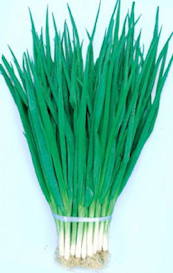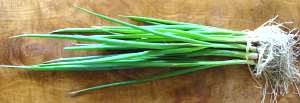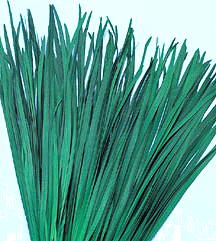SPECIALITY ONION SEED:
~ SALAD / BUNCHING / SPRING ONIONS ~
Salad onions, also known as Spring, Green or Bunching onions, don't make a bulb. Instead, they quickly make a white stem with green leaves at the top, and the whole plant is chopped up and used fresh in salads or cooking.
Quicker and milder than bulbing onions, use them chopped in soups, stews and omelettes, as well as in salads. These versatile plants give you some nice greens from a small area, often available when there is not much else in the garden.
When to sow? After midsummer, over wintering for use the following spring.
(Or, sow in Spring - shown in pale green below - for harvest from the start of July on into August.)
Small screen: Turn your device sideways to view sowing calendar.




















































 = normal sowing & harvest time
= normal sowing & harvest time![]()
 = also possible depending on conditions
= also possible depending on conditions
Kyoto Market - FOR GREEN LEAVES

We chose this well-known traditional variety from Japan because it has been particularly bred to make a lot of green leaves. Chop them all up and add to omlettes, soups, stew and salads.
It also splits into bunches as it grows and you can divide the clump to multiply your onion patch.
Green leaves, bunching type which divides as it grows.
![]() 300 seed
£
300 seed
£
 Ishikura
Long White - FOR WHITE STEM
Ishikura
Long White - FOR WHITE STEM
This is a very good, cold-hardy bunching onion, selected for making more white stem. It makes quite large spring onions quickly from either a spring or late summer sowing.
We like this as it gives you nice bunches of well-flavoured onions, for pulling up and using (both green and white bits) over winter.
Green leaves with a lot of white stem, bunching type which divides as it grows.
 200 seed, organic
£
200 seed, organic
£
~ Garlic Chives ~
 Chinese Chives (a.k.a. Garlic Chives)
Chinese Chives (a.k.a. Garlic Chives)
Chinese chives are an easily grown herb, very useful in the kitchen. Their clumps of distinctive flat leaves have rounded tips and a mild garlic flavour, hence their other common name of Garlic Chives.
We particularly like them snipped into an omelette. They actually make an underground rhizome and come back year after year, so once you have a clump established you have them forever.
![]() lots of seeds £
lots of seeds £
Stock:
TOPSETTING, WALKING or TREE ONIONS
~ grown from Sets ~
Here we have a botanical oddity for you. Topsetting onions are a class of bunching onions that are, well, a bit confused.
They grow normally, but when the time comes, instead of making a flower, they make a tiny bunch of bulbils on the end of the flowerstalk where the flower should be. Sometimes these then sprout while still attached, making a second set of bulbs at the top!
They are also known as 'Tree Onions' or 'Walking Onions' because the flowerstalk falls over, and the bulbils root where they touch the ground. The next year, these form onions in the new location, grow a stalk with bulbils on top - which then falls over . . . in this way they can walk a good foot every year and eventually migrate off your plot and into the wilds.
The onions are nice and hardy, and used as any bunching onion, while the bulbils can be used in pickles, or chopped up for cooking -but we think most people really want them for amusement as much as anything else.
Needless to say, you should never need to buy them again - just split up the bulbils and plant them out each year.
IMPORTANT: The tree onion bulbils that you receive will look quite dry and shrivelled. Don't worry! They grow really vigorously from very unpromising looking beginnings. But do plant them in a small pot in a frost-free place as soon as you receive them! As long as you plant upon receipt they should be fine and of course we will replace if it doesn't work.
To be fair, clear and avoid any disappointment, the reproductive bulbils we send out are small - about the size of a pea.
 one topsetting onion (4 bulbils supplied in a packet to be sure of at least one success)
£
one topsetting onion (4 bulbils supplied in a packet to be sure of at least one success)
£
If you don't get one established onion plant, then just email and of course we will refund or replace. (But most people report that all four bulbs take!)





